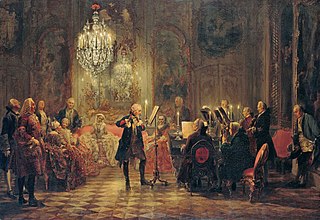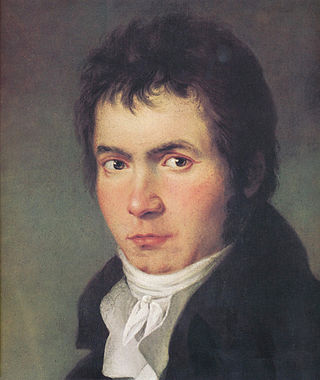Related Research Articles

Op. 70 is a set of two Piano Trios by Ludwig van Beethoven, written for piano, violin, and cello. Both trios were composed during Beethoven's stay at Countess Marie von Erdödy's estate, and both are dedicated to her for her hospitality. They were published in 1809.

The Piano Trio in B-flat major, Op. 97, by Ludwig van Beethoven is a piano trio completed in 1811. It is commonly referred to as the Archduke Trio, because it was dedicated to Archduke Rudolph of Austria, the youngest of twelve children of Leopold II, Holy Roman Emperor. Rudolf was an amateur pianist and a patron, friend, and composition student of Beethoven. Beethoven dedicated about a dozen compositions to him.

Ludwig van Beethoven was a German composer and pianist. He is one of the most revered figures in the history of Western music; his works rank among the most performed of the classical music repertoire and span the transition from the Classical period to the Romantic era in classical music. Beethoven's career has conventionally been divided into early, middle, and late periods. His early period, during which he forged his craft, is typically considered to have lasted until 1802. From 1802 to around 1812, his middle period showed an individual development from the styles of Joseph Haydn and Wolfgang Amadeus Mozart, and is sometimes characterized as heroic. During this time, he began to grow increasingly deaf. In his late period, from 1812 to 1827, he extended his innovations in musical form and expression.

The term string quartet can refer to either a type of musical composition or a group of four people who play them. Many composers from the mid-18th century onwards wrote string quartets. The associated musical ensemble consists of two violinists, a violist, and a cellist.

Chamber music is a form of classical music that is composed for a small group of instruments—traditionally a group that could fit in a palace chamber or a large room. Most broadly, it includes any art music that is performed by a small number of performers, with one performer to a part. However, by convention, it usually does not include solo instrument performances.
Sonata form is a musical structure generally consisting of three main sections: an exposition, a development, and a recapitulation. It has been used widely since the middle of the 18th century.
A scherzo, in western classical music, is a short composition – sometimes a movement from a larger work such as a symphony or a sonata. The precise definition has varied over the years, but scherzo often refers to a movement that replaces the minuet as the third movement in a four-movement work, such as a symphony, sonata, or string quartet. The term can also refer to a fast-moving humorous composition that may or may not be part of a larger work.

Vladimir Davidovich Ashkenazy is a Russian solo pianist, chamber music performer, and conductor. Born in the Soviet Union, he has held Icelandic citizenship since 1972 and has been a resident of Switzerland since 1978. Ashkenazy has collaborated with well-known orchestras and soloists. In addition, he has recorded a large repertoire of classical and romantic works. His recordings have earned him five Grammy awards and Iceland's Order of the Falcon.

Carl Czerny was an Austrian composer, teacher, and pianist of Czech origin whose music spanned the late Classical and early Romantic eras. His vast musical production amounted to over a thousand works and his books of studies for the piano are still widely used in piano teaching. He was one of Ludwig van Beethoven's best-known pupils and would later on be one of the main teachers of Franz Liszt.
A piano trio is a group of piano and two other instruments, usually a violin and a cello, or a piece of music written for such a group. It is one of the most common forms found in classical chamber music. The term can also refer to a group of musicians who regularly play this repertoire together; for a number of well-known piano trios, see below.

The Symphony No. 8 in F major, Op. 93 is a symphony in four movements composed by Ludwig van Beethoven in 1812. Beethoven fondly referred to it as "my little Symphony in F", distinguishing it from his Sixth Symphony, a longer work also in F.

AntonJoseph Reicha (Rejcha) was a Czech-born, Bavarian-educated, later naturalized French composer and music theorist. A contemporary and lifelong friend of Beethoven, he is now best remembered for his substantial early contributions to the wind quintet literature and his role as teacher of pupils including Franz Liszt, Hector Berlioz and César Franck. He was also an accomplished theorist, and wrote several treatises on various aspects of composition. Some of his theoretical work dealt with experimental methods of composition, which he applied in a variety of works such as fugues and études for piano and string quartet.

Ferdinand Ries was a German composer. Ries was a friend, pupil and secretary of Ludwig van Beethoven. He composed eight symphonies, a violin concerto, nine piano concertos, three operas, and numerous other works, including 26 string quartets. In 1838 he published a collection of reminiscences of his teacher Beethoven, co-written with Beethoven's friend, Franz Wegeler. Ries' symphonies, some chamber works—most of them with piano—his violin concerto and his piano concertos have been recorded, exhibiting a style which, given his connection to Beethoven, lies between the Classical and early Romantic styles.

The Cello Sonata No. 3 in A major, Op. 69, is the third of five cello sonatas by Ludwig van Beethoven. He composed it in 1807–08, during his productive middle period. It was first performed in 1809 by cellist Nikolaus Kraft and pianist Dorothea von Ertmann, a student of Beethoven. Published by Breitkopf & Härtel the same year, it was dedicated to Freiherr Ignaz von Gleichenstein, Beethoven's friend and an amateur cellist. The sonata was successful with audiences from the beginning.
D minor is a minor scale based on D, consisting of the pitches D, E, F, G, A, B♭, and C. Its key signature has one flat. Its relative major is F major and its parallel major is D major.

The Fantasy for piano, vocal soloists, mixed chorus, and orchestra, Op. 80, usually called the Choral Fantasy, was composed in 1808 by then 38-year-old Ludwig van Beethoven.
The Gryphon Trio is a Canadian classical music ensemble that has been nominated for several and has won three Juno Awards for its classical recordings released by the Analekta label. Its members are Annalee Patipatanakoon (violin), Roman Borys (cello) and Jamie Parker (piano).

The Beethoven Project Trio is an American piano trio that was formed in Chicago in 2008. Its founding members are pianist George Lepauw, violinist Sang Mee Lee and cellist Wendy Warner. The first public concert given by the trio was on March 1, 2009 at Chicago’s Murphy Auditorium for the world premiere of a recently rediscovered piano trio by Ludwig van Beethoven, as well as the American premiere of another Beethoven trio and the Chicago premiere of yet another Trio ; the performance also included the well-known “Archduke” Trio by Beethoven. John von Rhein, music critic of the Chicago Tribune, wrote about the trio's first concert that "for musicians who had never worked together as a trio before, pianist George Lepauw, violinist Sang Mee Lee and cellist Wendy Warner made a splendid ensemble, playing with finely judged balance, evenness of sound and unanimity of style [...] Lepauw, Lee and Warner ended their program with Beethoven’s familiar “Archduke” Trio, a masterpiece that drew fully on their individual and collective abilities. The slow movement emerged with particular eloquence here."

Ludwig van Beethoven composed at least six works for mandolin, four of which survive. None were published during his lifetime. Though known better as a pianist, Beethoven possessed a Milanese mandolin, which was hung beside his piano. He was friends with two prominent mandolinists, both of whom were linked to his surviving mandolin music.
References
- ↑ Anderson, Keith (2007). Beethoven: Piano Trios, Vol. 2 – Piano Trios Nos. 1, 2, 9 (CD). Naxos Records. 8.572343. Archived from the original on 11 December 2019. Retrieved 10 April 2016.
- ↑ Cooper, Barry (2000). Beethoven . United States: Oxford University Press. p. 225. ISBN 978-0191592706.